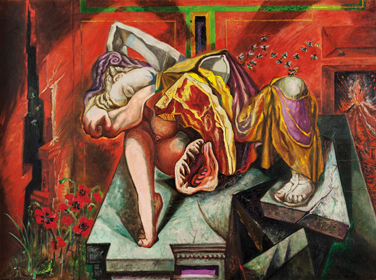/
EN
| Andre Masson Gradiva 1939 Centre Pompidou Paris, France |
|
Rights (Photo / Work):
© Bildrecht, Wien, 2013 List of sources: |
In 1907 the psychoanalyst Sigmund Freud made an analysis of the protagonist of a novel, an arachaeologist who was so impressed by a relief figuring a young woman, Gradiva, that she appeared in his dreams.1 Freud ascertained that these dreams are the result of feelings unaccomplished during his childhood. Masson's painting has the same title and reminds the said stone-carving, since the woman is standing on a stone pedestal. Parts of the female body werde taken apart and symbolically reconstructed. So the female genitalia have been detached from the body, the vagina is depicted as mouth with teeth and reminds the viewer of a so-called "Vagina Dentata" (toothed vagina), a notion created by Freud, thematising the man's castration anxiety. The painting includes several motives, such as the danger emanating from female sexuality, an unconscious desire or the fear of being devoured.
Biography: http://de.wikipedia.org/wiki/André_Masson (Translation: K. Seifter)
|



